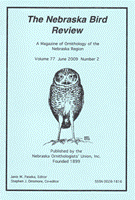Nebraska Ornithologists' Union

Nebraska Bird Review
Date of this Version
12-2020
Document Type
Article
Citation
The Nebraska Bird Review Vol. 88 No. 4, pp. 138-161.
Abstract
Two issues were of concern this fall, and both appeared to have consequences or at least similarities in Nebraska. A major die-off in New Mexico made national news: https://www.aba.org/the-data-behind-mysterious-bird-deaths-in-new-mexico/. On Sep 9, 2020, the temperature dropped from 96°F to 40°F in the Albuquerque area, a record low, winds reached 70 mph, and several inches of snow fell, killing large numbers of birds directly. Over the next few days, hundreds more dead birds were picked up. Some have linked this high mortality to birds displaced from the mountains due to fire and unfortunately being caught in the severe weather. While fire effects may have contributed, the parsimonious explanation was thought to be starvation and dehydration in the region where the die-off occurred as a result of a concurrent drastic drop in insect numbers; most carcasses had no fat and some showed muscle atrophy. In Nebraska, we may have experienced similar effects. Probably due to the same weather system, numbers of mosquitos dropped drastically in mid-Sep at least in Lincoln, Lancaster County (John Carlini, Shari Schwartz, Esa Jarvi) and nearby northwestern Missouri (Paula Hoppe); numbers of dead Barn Swallows were found at the same time.
This fall, a remarkable phenomenon was the many record and near-record high counts of generally common birds in the west and southwest; it is tempting to relate these high numbers of birds to the extensive fires to the west in the Rocky Mountains. Birds that normally migrate in eastern parts of the Rockies may have been pushed eastward: possible examples are the single observer/single location counts of 50 Pygmy Nuthatches, 26 Cassin’s Finches, 470 Pine Siskins, 18-20 Lesser Goldfinches, 71 Yellow Warblers, and 84 Wilson’s Warblers. Of course, one would expect such an event to bring mountain birds as well, but there was no significant influx of mountain specialties like Steller’s Jay and Clark’s Nutcracker although both put in appearances. Curiously, however, at Chadron State Park, Bird Conservancy of the Rockies bander Robert Snowden reported the lowest capture rate in 13 years. Maybe the explanation is simple: extensive coverage of the southwest by Steve Mlodinow and other experienced visiting observers.
There was much more to contemplate this fall, in several categories: high numbers of birds, high numbers of reports, early and late occurrences, species out of range, a miscellany section, and of course a plethora of rarities. Startlingly high numbers included a record 28,500 Cackling Geese, 417 Wood Ducks on one pond, 59 Sage Thrashers overall including 19 at one location, the afore-mentioned 470 Pine Siskins, 61 Field Sparrows in the west, 255 White-crowned Sparrows, 60 Lincoln’s Sparrows, 71 Yellow Warblers, and 84 Wilson’s Warblers.
Numbers of reports for certain species were impressive; eight Red-necked Grebes were at six locations, there were 16 reports of Hammond’s Flycatcher, 17 Mountain Chickadees were found east to North Platte, there were 11 westerly reports of Winter Wren compared to the prior 15, and there were seven reports of westerly Blackpoll Warblers, normally rare in fall even in the east, compared to the prior nine westerly reports. And it was a “major flight year” for Northern Saw-whet Owls. Most early/late occurrences of note recently have been of fall lingerers; this fall notable were late Oct reports of Black-necked Stilt and Summer Tanager, and late Nov reports of American Woodcock, White-faced Ibis, and Nelson’s Sparrow. Often as rare as low-digit state records are birds displaced east or west of their usual ranges. First Panhandle records were made by Yellow-bellied Flycatcher, Sedge Wren in fall, and Connecticut Warbler, while an amazing western bird east was a Brewer’s Sparrow in Lancaster County, first for over 100 years away from the Panhandle. Additional westerly reports were of American Black Duck, Philadelphia Vireo, Mourning Warbler, and Blackpoll Warbler, while easterly were a Red-naped Sapsucker, Cassin’s Vireos, Plumbeous Vireos, and a Yellow-rumped (Audubon’s) Warbler. The miscellany included subspecies discussion for Hermit Thrush and Song Sparrow in the west, unusual hybrids between Northern Pintail and Green-winged Teal and between Neotropic and Double-crested Cormorants, a possible developing trend of late-nesting Black-bellied Whistling-Ducks, and a good dispersal of Carolina Wrens similar to that of 2019. And finally, an amazing list of rarities, led by 2nd state records of Fulvous Whistling- Duck and Magnificent Frigatebird (identified to species), 4th Reddish Egret, 5th Yellowbilled Loon (pending NOURC), 5th and 6th Anna’s Hummingbirds, 6th Arctic Tern, 8th Harris’s Hawk, and 9th and 10th Gray Flycatchers. All of these topics are covered in more detail in the following species accounts - read on and enjoy!
Included in
Ornithology Commons, Population Biology Commons, Poultry or Avian Science Commons, Zoology Commons


Comments
Published by the Nebraska Ornithologists’ Union, Inc.